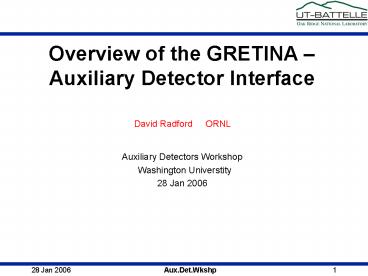David Radford ORNL PowerPoint PPT Presentation
1 / 17
Title: David Radford ORNL
1
Overview of the GRETINA Auxiliary Detector
Interface
- David Radford ORNL
Auxiliary Detectors Workshop Washington
Universtity 28 Jan 2006
2
Outline
- The Plan from the point of view of GRETINA
(Requirements document) - The needs of the Aux Detector builders
- Can we arrange some way(s) to make the interface
easy? - - Lots of overlap with following talks by Sergio
and Mario
3
Data Acquisition system
Local Trigger Module
Signal Digitizers
Readout Computer
2.2 MB/s
66 MB/s
Processing Farm
Global Trigger Module
Network Switch
75 dual Processors
30 Crystals
6.9 MB/s
Aux. Det. Trigger
Workstations, Servers
Data Storage
Aux. Det. Data
2.3 MB/s Aux. Data
4
Event Processing
Data from Germanium Detectors
36 segments per detector
Segment events
Event Building Data Flow
Crystal Event Builder
Crystal events
Signal Decomposition
Interaction points
1-30 crystals
Data from Auxiliary Detectors
Global Event Builder
Global Events
Tracking
Analysis Archiving
5
Data Merging
- Event building is done on the basis of
timestamps. - In order to merge the two data streams, the Aux.
Det. data must include the same timestamps as the
Ge data. - This is really the only constraint on the Aux.
Det. data stream. - Is there an easy way to implement it?
6
The Trigger
- The Global Trigger Module will provide for 8 8
general purpose input output lines for the aux.
detectors. - The details of the implementation have not been
finalized yet - Will it be synchronous or asynchronous
(timestamps)? - If asynchronous, how will the timestamps be made?
- How much latency will be allowed?
7
Easiest Solution?
- One easy solution for both the data stream and
the trigger is simply to use the GRETINA
digitizers for your auxiliary detectors. - Identical timestamps, clock synchronization
- Easy integration into the trigger system
- Dont (usually) have to worry about trigger
latency - Digital pulse processing is ideal for e.g. CsI,
neutron detectors, etc. anything requiring
Pulse-Shape Analysis - Flexible preprocessing no need to read out
waveforms
8
Data Acquisition system
Local Trigger Module
Signal Digitizers
Readout Computer
2.2 MB/s
66 MB/s
Ge detectors
Processing Farm
Global Trigger Module
Network Switch
75 dual Processors
6.9 MB/s
Workstations, Servers
Aux. detectors
Data Storage
2.3 MB/s Aux. Data
Local Trigger Module
Signal Digitizers
Readout Computer
9
Easiest Solution (contd)
- Should we ask DOE for money for some number
(100-200?) channels of digitizer to be reserved
for auxiliary detectors?
10
Next Easiest Solution?
- Use at least one GRETINA digitizer, to digitize
anything, even a logic signal - Use VME ADCs / interfaces / bridges for remaining
signals - GRETINA digitizer provides timestamps, clock
synchronization - Trigger system not quite as easy will need to
generate gates and read-out triggers for the
other modules - Therefore we have to worry about trigger latency
11
Data Acquisition system
Local Trigger Module
Signal Digitizers
Readout Computer
2.2 MB/s
66 MB/s
Ge detectors
Processing Farm
Global Trigger Module
Network Switch
75 dual Processors
Signal ADCs / Digitizer Interface
6.9 MB/s
Workstations, Servers
Readout Computer
Data Storage
Aux. detectors
2.3 MB/s Aux. Data
12
Next Easiest Solution (contd)
- Could replace the GRETINA digitizer with a
special timestamp / clock synchronization module - Another option for high channel counts (Lee
Sobotka et al.) - Shaper peak-detect-and-hold on each channel
- ? time-slice-multiplex multiple channels
- ? a single analog pulse train for multiple
channels - ? digitize in a GRETINA digitizer channel
13
Trigger Latency?
- GRETINA needs to know about the Aux Det event in
order to decide on the master trigger - How much time do we have to provide that
information? - The Aux Det modules need gates and validation
signals, generally provided by the master trigger - How quickly do we need that information?
- i.e. How much time do we have to collect all the
master trigger info, make a decision, and
generate synchronous logic signals for gates?
14
Trigger Latency?
- E.g. Microball
- Trigger info available from mBall at 0.5 ms
- First gates needed for mBall ADCs at 0.8 ms
- Max. trigger
latency - Could GRETINA meet this schedule?
- What if it couldnt?
- Alternative mode Fast Clear increases dead
time significantly
15
Readout Bandwidth
- VME 64x Bus Bandwidth
- In principle 160 MB/s
- Readout CPU to Farm
- GigE 120 MB/sec
- Readily achievable 60 MB/s?
- High enough for all aux. detectors?
16
Two Important Types of AuxDet
- To help determine t0 for the event
- May be important for signal decomposition
- Improve position resolution
- E.g. BaF2, LaCl
- To determine recoil direction, velocity
- For Doppler correction
- Energy resolution
- Need 10 mrad
17
Doppler Broadening
V?DV
Doppler shift
Moving nucleus
D?N
?
D?D
g-ray detector
- Broadening of detected gamma ray energy due to
- ? Spread in speed DV
- ? Distribution in the direction of velocity D?N
- ? Detector opening angle D?D
- ?Need accurate determination of V and ?.
- ? Position sensitive g-ray detector and particle
detector

